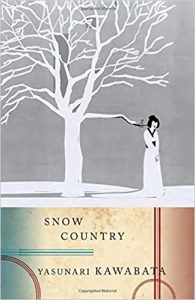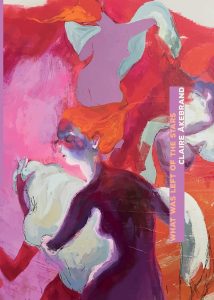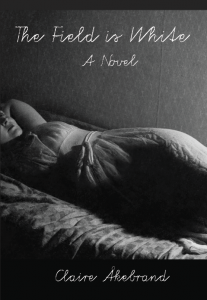Though my novel The Field Is White concerns a Mormon missionary and has a very Doctrine & Covenants title, I neither think of it as Mormon literature, nor a book about Mormons. It is a novel foremost about love, death, the purpose of art, forgetfulness, family, and time. My novel is for anyone of any background who is interested in literary fiction and who finds pleasure in slowed pace, figurative language. and self-indulgent ruminations.
I started writing The Field Is White six years ago. My husband and I were living in Frankfurt, Germany for a year. We didn’t have a car and therefore relied on trains and busses. We walked a lot. I remember listening to Rachmaninov often during that time. His Prelude in G Minor, the rapid tempo of it, kept creating this vision for me of a missionary trudging through a heavy blizzard.
I wanted to get to know this imagined missionary. Why did he keep coming back to me? As I began to write my way toward the idea of him, he turned out to be John Eliason from Lethbridge, Alberta serving a mission in Sweden in the 50s. He baptizes an old poet named Emil Quist (curiously similar to my own grandfather Holger Bergius). Turns out, John is losing his faith. He doesn’t want to go back to Alberta where familial trouble awaits him. He uses his convert’s death as an excuse to escape to the countryside where he seeks out the estranged family. As the snow strands him with the widow and daughter, tensions rise and John learns some uncomfortable things about Emil.
I was raised with stories of my maternal and paternal grandparents’ conversions to Mormonism in Sweden in the 50s. My grandfather Holger had flirted with many religions before obtaining a copy of the Book of Mormon from missionaries at a fair. He was baptized soon after. I was always fascinated by the idea of my very Swedish relatives attempting to live a very American religion. These American missionaries must have seemed so alien and exotic and exciting to them.
My grandfather was a writer, painter, and musician. Though his conversion, creative endeavors, and dysfunctional marriage served as an inspiration for the book, most of the details are invented or heavily embellished.
In all this, John Eliason acts as a mediator for me to slantly tell a part of my family’s story.
 At the time I started writing The Field Is White, I had just fallen deeply in love with Faulkner’s Absolom, Absolom! and Kawabata’s Snow Country. I coveted Faulkner’s dizzy narrative and overwhelming floods of thoughts. I wanted Kawabata’s moody landscapes and precise descriptions. Both of these books guided me in the creation of my novel.
At the time I started writing The Field Is White, I had just fallen deeply in love with Faulkner’s Absolom, Absolom! and Kawabata’s Snow Country. I coveted Faulkner’s dizzy narrative and overwhelming floods of thoughts. I wanted Kawabata’s moody landscapes and precise descriptions. Both of these books guided me in the creation of my novel.
Kawabata’s Snow Country begins with a train ride. A man named Shimamura watches a beautiful woman taking care of an aged man. As her face’s reflection in the train window floats through the snowy landscape, Shimamura is overcome by the beauty and sadness of it. The open-ended book reads like a Basho haiku—every image seems deliberate and simple and endlessly evocative. I wanted to write something evocative and image-driven like that, to create an atmosphere that was literal and yet bordered on the surreal.
My book too begins with a snowy train ride and a woman. The following excerpt is the first chapter of The Field Is White. I like to think of it as a kind of fan mail to Kawabata’s heartrendingly lovely novel.
The Field is White
The middle-aged woman who almost missed the train, turns
from the pale rhythm of aspen trees outside the window and looks at the
missionary. “Do you know the time?” She points at her bare wrist.
Her voice unsettles the young man. It makes her almost unbearably
present. He pushes back his sleeve to check the time but the secondhand
is motionless. “I’m sorry,” he replies confused. “I don’t know.” He keeps
looking at it but the watch remains frozen – the watch Emil gave him.
Simple, black and white. If it breaks, it’s broken, Emil had warned him. He
holds the watch up to his ear. His eyes seem to search for a sound off in
some distance.
The woman holds her hand out. He doesn’t understand her gesture.
“Let me see it,” she turns the watch over a few times, leans her ear
against it and waits. “It’s broken.” When she hands the watch back to him,
he imagines it is warmer than before.
“Are you American?” She seems surprised by his voice. He tries to
explain where Lethbridge, Alberta lies in the palm of his hand until her face
lights with artificial recognition. Her grey eyes like the grey of embers.
“A cowboy,” she smiles with her mouth only. Her teeth are too big.
“My grandfather loves Westerns.” She brushes a few invisible strands from
her forehead and removes her coat revealing broader shoulders than he
expected. The flower dress makes him look away, as he imagined something
more neutral, a brown dress or blouse. The unidentifiable flowers flow down
her shoulders, chest, and hips to just below her knees—pastel pink and green
against a brown background. Her shape emanates the warmth that has been
trapped in the large wool coat. As if she has opened the door to a furnished
apartment full of pillows and warm things. When she first boarded the train
and before she talked to him, she had not moved at all. She just slumped
into her seat without taking her coat off and stared out into the long aisle
catching her breath for a long time as if she had escaped something.
“You remind me of Ingrid Bergman,” he imagines himself flattering
her. His boyish face flushes at the idea. It’s not even true.
“Where are you going?” she asks.
“Bowrose.”
His drawl makes her pinch her lips together to avoid laughing.
“Borås? What’s in Borås?” she shows off her seamless accent.
“I am going to see a family whose father died.”
Neither say anything for a moment. She turns her gaze toward the
window. The light and shadows of snow-burdened things flickering over
her face. In the snow light, her skin looks slightly fuzzy where earlobe meets
jaw. He wonders if her mousy hair used to be lighter in her youth. Her gaze
follows a crow gliding over a white field, settling on a yellow barn. “Borås
has to be the most dreadful town in Sweden. When it’s not snowing, it’s
raining.” She slides her hand into her dress, over her shoulder to adjust
something. “Unpleasant business.”
“What is?” he asks.
“Funeral arrangements.” Her face turns to him waiting for a
reaction. “You better take care you don’t get stuck there.” She looks back
at a nameless, frozen lake. “There’s a snowstorm coming.” The skin of her
neck seems to him like the barest skin he has seen. Sifted flour. Intangible.
“You don’t want to spend New Year’s there.”
Silence sounds the same in every city of every country, he thinks.
He doesn’t want to discuss religion with her. Says nothing. The light of
curiosity in her eyes has faded. His eyes cling to her face as if he could turn
the light back on again. She closes her eyes.
The fields of snow and black trees pulse in and out of light until
pink, then blue, then gray, and finally melted in dusk. The blueness presses
against the windows, the night that followed him from Lethbridge. The big
emptiness. The stars’ vacancy. Like a congregation of phantoms, expired
promises never meant to be kept. One summer night when John was eight,
his father woke him up to show him the sky. He wondered why his father
had chosen him. But he was the one his father gently shook and led outside.
His father pointing up, “Look”. Heaven seemed somehow more infinite, as
intimate as peering through a black wool sweater. The darkness smelling of
river moss and flowers.
John nearly lost his footing under all that light, as if the world had
been turned upside down, sparks and ashes floating down on him from
impossibly distant bonfires. Wildfires. Stars like shedding wildflower fields—
buttercup, cinquefoil, fairy bell, fireweed, harebell, grass-of-parnassus, ox-eye
daisy, larkspur, wood lily, goldenrod, arnica—falling from their upside-down
fields, tumbling toward John and his father. How long did they stand there?
John’s eight-year-old self has remained there all these years with the lighs
still multiplying overhead. The silhouette of his father’s arm pointing to
constellations. The erotic sound of “Cassiopeia.” He was astounded by all
the star names he didn’t know and all the stars that didn’t have names and
never would. The stars both flooded in and out of him. The stars quivering,
bursting above him, like a black pond suddenly broken by a pebble; characters
of a lost number system; words of an unknown language – all secrets and
mysteries of life finally spelled out in the clearest, most indecipherable
sentences. Nothing foreign and other about them. Manufactured out of the
same materials as memories, hopes, and fears. The stars that had been losing
their light for millions of years and would continue indefinitely to be in a
state of losing the one thing that defines them—light. No end to the loss of
light. No end to the darkness that bears the losing light.
If only the train never arrived anywhere, he thinks—numberless
dark corridors and unlabeled doors; unending stations named Alingsås,
Lund, and Ekby; a man in a dark blue uniform absent-mindedly checking
tickets, who wears a dark green belt around his waist with a small leather
pouch for change that jingles as he walks; a woman sleeping in a flower
dress.
Two Hungarian men in dull suits play cards. The man in the hat has
hiccups. They do not speak. The blond with the hooked profile has a pipe
hanging from his lips. He isn’t smoking it. He keeps grabbing the matches
from the table and putting them back without lighting the pipe. It makes the
missionary want to jump up and light the pipe for him. The smell of raw
tobacco like raisins. Occasionally one of the men lets out a cry of triumph
or defeat. Each time, a drowsing toddler on his father’s lap seated behind the
men, jumps and then sinks lip-smacking back into his sleep. Twitching his
leg. John, too, slips into sleep.
The train jolts and makes John dream he is falling. He opens his
eyes. Passengers leave fingerprints and breath-clouds all over the windows
while trying to see why the train stopped. Nothing but forest and snow
strewn with shadows of spruce trees. No station in sight. A train worker
passing through the cars, assures passengers that they’ll be on their way
again soon.
“Look, over there,” a woman with a Skåne dialect nearly whispers.
“It’s coming closer,” another dialect says.
The two card-players stand up to get a better view. They motion for
the missionary and the woman to join them in the window. “It’s not afraid,”
the man who smells like bacon says pressing his open deck of cards against
the window. The woman touches the glass gently as if it were the moose’s
side.
The large animal walks out of the edge of the woods. Its antlers
sway effortlessly balanced as it descends toward the tracks. It lifts its long
face to nose the window. The moose appears to weigh less even than the
snowflakes melting on its back. As vast as the train. It steers the prow of
its head back to the forest without disturbing the sea of dusk, casts one last
glance at the train and flows into the aspen darkness.

 Claire Åkebrand is the author of the novel The Field Is White (Kernpunkt Press 2017) and the poetry collection What Was Left Of The Stars (Serpent Club Press 2017). Her poetry has appeared in the Manchester Review, the Beloit Poetry Journal, BOAAT, and elsewhere. She was shortlisted for the 2017 University of Canberra Vice-Chancellor’s International Poetry Prize judged by Billy Collins. She is a Swede who grew up in Germany and Utah, and currently lives in Provo with the poet Michael Lavers and their two children.
Claire Åkebrand is the author of the novel The Field Is White (Kernpunkt Press 2017) and the poetry collection What Was Left Of The Stars (Serpent Club Press 2017). Her poetry has appeared in the Manchester Review, the Beloit Poetry Journal, BOAAT, and elsewhere. She was shortlisted for the 2017 University of Canberra Vice-Chancellor’s International Poetry Prize judged by Billy Collins. She is a Swede who grew up in Germany and Utah, and currently lives in Provo with the poet Michael Lavers and their two children.


Here is an excerpt from Laura Stott’s review of the book, which will appear in an upcoming Dialogue. “‘The Field is White’ reads like poetry and feels, in the mind’s eye, like something out of an old movie. But it’s a story that’s never been told, set in the whiteness of a snow storm that doesn’t want to end . . . The sections of the book, I wouldn’t call them chapters, are braided together following the story of the characters through various stages of life, as time unfolds, so do their secrets. Some sections are lyrical and short, others more narrative or scene driven. The unfolding that is slowly created makes for some interesting methods of foreshadowing and allows time to fold back in on itself as we relive and remember where the story began . . . I like that this book unpacks the stillness, the strangeness, and humanity that surrounds us, through its characters, language and imagery. Everything slows down as you read, like in the book, a stopped watch.”
John Bennion, on the publisher’s page: “IN THIS EXQUISITE FIRST NOVEL, CLAIRE AKEBRAND MAKES THE DOMESTIC EXOTIC THROUGH EXACT OBSERVATION. HER PARTICULAR VISION OF THIS PROTAGONIST—AN OFF-THE-RAILS MORMON MISSIONARY—AND THIS PLACE—A SNOWBOUND HOUSE OUTSIDE A SWEDISH VILLAGE, FILLED WITH MEMORIES THAT ARE NOT HIS OWN—IS SO PROFOUND, THAT AKEBRAND TRANSFORMS THIS WORLD INTO INCREDIBLE RICHNESS. THE SNOW BURYING EVERYTHING, THE VOICE OF A WOMAN TRAPPED IN THE PAST, THE SMELL OF WOOD SMOKE, THE RUSTLING OF PAGES OF MANUSCRIPT POEMS, THE REPEATED ACTIONS OF SLEEPING, WAKING, COOKING, EATING. AN OWL THAT PASSES, “RUSTLING LIKE THE SILKEN TRAIN OF A DRESS ACROSS FLOORBOARDS.” IN THIS PLACE TIME PAUSES SO THAT “CHANGES COME ABOUT QUIETLY LIKE CURTAINS SLOWLY BLEACHED IN THE SUNLIGHT.” AKEBRAND’S SKILL IS OF THE POET, THE ABILITY TO OBSERVE CLOSELY AND METAPHORICALLY, TO SEE AND FEEL, AND OF THE NOVELIST, MAKING DRAMAS OUT OF THE MUNDANE. WHAT AKEBRAND HAS INVENTED IS NO LESS THAN A NEW WAY OF SEEING, CREATING A NARRATIVE THAT GAINS TENSION AS IT POOLS AND EDDIES, MOVING IN CIRCULAR, RHYTHMIC TIME.”